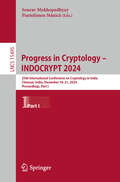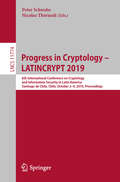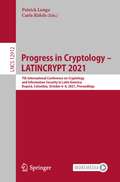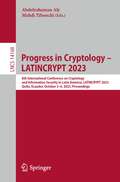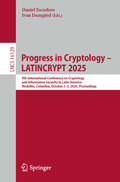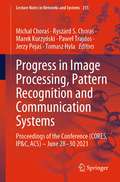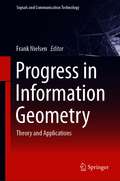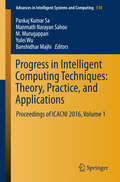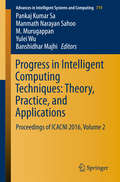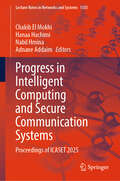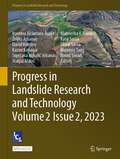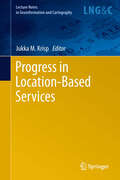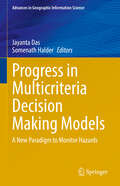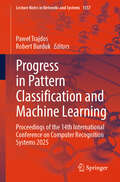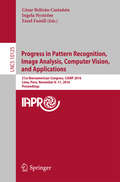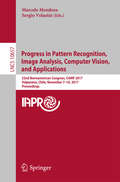- Table View
- List View
Progress in Cryptology – INDOCRYPT 2024: 25th International Conference on Cryptology in India, Chennai, India, December 18–21, 2024, Proceedings, Part I (Lecture Notes in Computer Science #15495)
by Pantelimon Stănică Sourav MukhopadhyayThis 2-volume set LNCS 15495-15496 constitutes the refereed proceedings of the 25th International Conference on Cryptology in India, held in Chennai, India, during December 18–21, 2024. The 31 full papers presented in these proceedings were carefully reviewed and selected from 96 submissions. They are organized into these topical sections: Part I: Foundations; symmetric-key cryptography; cryptographic constructions; and quantum cryptography. Part II: Cryptanalysis; post-quantum cryptography; and blockchain and cloud computing.
Progress in Cryptology – INDOCRYPT 2024: 25th International Conference on Cryptology in India, Chennai, India, December 18–21, 2024, Proceedings, Part II (Lecture Notes in Computer Science #15496)
by Pantelimon Stănică Sourav MukhopadhyayThis 2-volume set LNCS 15495-15496 constitutes the refereed proceedings of the 25th International Conference on Cryptology in India, held in Chennai, India, during December 18–21, 2024. The 31 full papers presented in these proceedings were carefully reviewed and selected from 96 submissions. They are organized into these topical sections: Part I: Foundations; symmetric-key cryptography; cryptographic constructions; and quantum cryptography. Part II: Cryptanalysis; post-quantum cryptography; and blockchain and cloud computing.
Progress in Cryptology – LATINCRYPT 2017: 5th International Conference on Cryptology and Information Security in Latin America, Havana, Cuba, September 20–22, 2017, Revised Selected Papers (Lecture Notes in Computer Science #11368)
by Orr Dunkelman Tanja LangeThis book constitutes the refereed post-conference proceedings of the 5th International Conference on Cryptology and Information Security in Latin America, LATINCRYPT 2017, held in Havana, Cuba, in September 2017.The 20 papers presented were carefully reviewed and selected from 64 submissions. They are organized in the following topical sections: security protocols; public-key implementation; cryptanalysis; theory of symmetric-key cryptography; multiparty computation and privacy; new constructions; and adversarial cryptography.
Progress in Cryptology – LATINCRYPT 2019: 6th International Conference on Cryptology and Information Security in Latin America, Santiago de Chile, Chile, October 2–4, 2019, Proceedings (Lecture Notes in Computer Science #11774)
by Peter Schwabe Nicolas ThériaultThis book constitutes the proceedings of the 6th International Conference on Cryptology and Security in Latin America, LATINCRYPT 2019, held in Santiago di Chile, Chile, in October 2019. The 18 revised full papers presented were carefully reviewed and selected from 40 submissions. The papers are organized in topical sections on cryptoanalysis, symmetric cryptography, ide-channel cryptography, post-quantum cryptography, signatures and protocols, and implementation.
Progress in Cryptology – LATINCRYPT 2021: 7th International Conference on Cryptology and Information Security in Latin America, Bogotá, Colombia, October 6–8, 2021, Proceedings (Lecture Notes in Computer Science #12912)
by Patrick Longa Carla RàfolsThis book constitutes the proceedings of the 7th International Conference on Cryptology and Information Security in Latin America, LATIN 2021, which was held in October 2021. The conference was originally planned to take place in Bogota, Colombia, but changed to a virtual event due to the COVID-19 pandemic. The 22 full papers included in this volume were carefully reviewed and selected from 47 submissions. They were organized in topical sections as follows: quantum cryptography; post-quantum cryptography; asymmetric cryptanalysis; cryptanalysis and side-channel analysis; distributed cryptographic protocols; and multiparty computation.
Progress in Cryptology – LATINCRYPT 2023: 8th International Conference on Cryptology and Information Security in Latin America, LATINCRYPT 2023, Quito, Ecuador, October 3–6, 2023, Proceedings (Lecture Notes in Computer Science #14168)
by Mehdi Tibouchi Abdelrahaman AlyThis book constitutes the refereed proceedings of the 8th International Conference on Progress in Cryptology, LATINCRYPT 2023, held in Quito, Ecuador, in October 2023. The 19 full papers included in this book were carefully reviewed and selected from 59 submissions. They were organized in topical sections as follows: Symmetric-Key Cryptography; Multi-Party Computation; Isogeny-Based Cryptography; Discrete Logarithm Problem; Cryptographic Protocols; Real-World Cryptography; and Zero-Knowledge Proofs.
Progress in Cryptology – LATINCRYPT 2025: 9th International Conference on Cryptology and Information Security in Latin America, Medellín, Colombia, October 1–3, 2025, Proceedings (Lecture Notes in Computer Science #16129)
by Daniel Escudero Ivan DamgårdThis book constitutes the refereed proceedings of the 9th International Conference on Cryptology and Information Security in Latin America, LATINCRYPT 2025, held in Medellín, Colombia, in October 2025. The 17 full papers included in this book were carefully reviewed and selected from 41 submissions.They were focused on the following topical sections: Position Paper; Zero-Knowledge Proofs and Distributed Computation; Quantum and Post-Quantum Cryptography; Symmetric-Key Cryptography and Attacks; Machine Learning and Cryptanalysis; and Implementation and Efficiency.
Progress in Differential-Algebraic Equations II (Differential-Algebraic Equations Forum)
by Sebastian Schöps Timo Reis Sara GrundelThis book contains articles presented at the 9th Workshop on Differential-Algebraic Equations held in Paderborn, Germany, from 17–20 March 2019. The workshop brought together more than 40 mathematicians and engineers from various fields, such as numerical and functional analysis, control theory, mechanics and electromagnetic field theory. The participants focussed on the theoretical and numerical treatment of “descriptor” systems, i.e., differential-algebraic equations (DAEs).The book contains 14 contributions and is organized into four parts: mathematical analysis, numerics and model order reduction, control as well as applications. It is a useful resource for applied mathematicians with interest in recent developments in the field of differential algebraic equations but also for engineers, in particular those interested in modelling of constraint mechanical systems, thermal networks or electric circuits.
Progress in Geospatial Analysis
by Yuji MurayamaThis book examines current trends and developments in the methods and applications of geospatial analysis and highlights future development prospects. It provides a comprehensive discussion of remote sensing- and geographical information system (GIS)-based data processing techniques, current practices, theories, models, and applications of geospatial analysis. Data acquisition and processing techniques such as remote sensing image selections, classifications, accuracy assessments, models of GIS data, and spatial modeling processes are the focus of the first part of the book. In the second part, theories and methods related to fuzzy sets, spatial weights and prominence, geographically weighted regression, weight of evidence, Markov-cellular automata, artificial neural network, agent-based simulation, multi-criteria evaluation, analytic hierarchy process, and a GIS network model are included. Part three presents selected best practices in geospatial analysis. The chapters, all by expert authors, are arranged so that readers who are new to the field will gain an overview and important insights. Those readers who are already practitioners will gain from the advanced and updated materials and state-of-the-art developments in geospatial analysis.
Progress in Image Processing, Pattern Recognition and Communication Systems: Proceedings of the Conference (CORES, IP&C, ACS) - June 28-30 2021 (Lecture Notes in Networks and Systems #255)
by Ryszard S. Choraś Jerzy Pejaś Marek Kurzyński Tomasz Hyla Michal Choraś Paweł TrajdosThis book presents a collection of high-quality research papers accepted to multi-conference consisting of International Conference on Image Processing and Communications (IP&C 2021), International Conference on Computer Recognition Systems (CORES 2021), International Conference on Advanced Computer Systems (ACS 2021) held jointly in Bydgoszcz, Poland (virtually), in June 2021. The accepted papers address current computer science and computer systems-related technological challenges and solutions, as well as many practical applications and results. The first part of the book deals with advances in pattern recognition and classifiers, the second part is devoted to image processing and computer vision, while the third part addresses practical applications of computer recognition systems. Machine learning solutions for security and networks are tackled in part four of the book, while the last part collects papers on progress in advanced computer systems. We believe this book will be interesting for researchers and practitioners in many fields of computer science and IT applications.
Progress in Industrial Mathematics at ECMI 2018 (Mathematics in Industry #30)
by István Faragó Péter L. Simon Ferenc IzsákThis book explores mathematics in a wide variety of applications, ranging from problems in electronics, energy and the environment, to mechanics and mechatronics. The book gathers 81 contributions submitted to the 20th European Conference on Mathematics for Industry, ECMI 2018, which was held in Budapest, Hungary in June 2018. The application areas include: Applied Physics, Biology and Medicine, Cybersecurity, Data Science, Economics, Finance and Insurance, Energy, Production Systems, Social Challenges, and Vehicles and Transportation. In turn, the mathematical technologies discussed include: Combinatorial Optimization, Cooperative Games, Delay Differential Equations, Finite Elements, Hamilton-Jacobi Equations, Impulsive Control, Information Theory and Statistics, Inverse Problems, Machine Learning, Point Processes, Reaction-Diffusion Equations, Risk Processes, Scheduling Theory, Semidefinite Programming, Stochastic Approximation, Spatial Processes, System Identification, and Wavelets. The goal of the European Consortium for Mathematics in Industry (ECMI) conference series is to promote interaction between academia and industry, leading to innovations in both fields. These events have attracted leading experts from business, science and academia, and have promoted the application of novel mathematical technologies to industry. They have also encouraged industrial sectors to share challenging problems where mathematicians can provide fresh insights and perspectives. Lastly, the ECMI conferences are one of the main forums in which significant advances in industrial mathematics are presented, bringing together prominent figures from business, science and academia to promote the use of innovative mathematics in industry.
Progress in Industrial Mathematics at ECMI 2021 (Mathematics in Industry #39)
by Michael Günther Matthias EhrhardtThis book gathers peer-reviewed contributions submitted to the 21st European Conference on Mathematics for Industry, ECMI 2021, which was virtually held online, hosted by the University of Wuppertal, Germany, from April 13th to April 15th, 2021. The works explore mathematics in a wide variety of applications, ranging from problems in electronics, energy and the environment, to mechanics and mechatronics. Topics covered include: Applied Physics, Biology and Medicine, Cybersecurity, Data Science, Economics, Finance and Insurance, Energy, Production Systems, Social Challenges, and Vehicles and Transportation. The goal of the European Consortium for Mathematics in Industry (ECMI) conference series is to promote interaction between academia and industry, leading to innovations in both fields. These events have attracted leading experts from business, science and academia, and have promoted the application of novel mathematical technologies to industry. They have also encouraged industrial sectors to share challenging problems where mathematicians can provide fresh insights and perspectives. Lastly, the ECMI conferences are one of the main forums in which significant advances in industrial mathematics are presented, bringing together prominent figures from business, science and academia to promote the use of innovative mathematics in industry.
Progress in Information Geometry: Theory and Applications (Signals and Communication Technology)
by Frank NielsenThis book focuses on information-geometric manifolds of structured data and models and related applied mathematics. It features new and fruitful interactions between several branches of science: Advanced Signal/Image/Video Processing, Complex Data Modeling and Analysis, Statistics on Manifolds, Topology/Machine/Deep Learning and Artificial Intelligence. The selection of applications makes the book a substantial information source, not only for academic scientist but it is also highly relevant for industry. The book project was initiated following discussions at the international conference GSI’2019 – Geometric Science of Information that was held at ENAC, Toulouse (France).
Progress in Intelligent Computing Techniques: Theory, Practice, and Applications
by Pankaj Kumar Sa Manmath Narayan Sahoo M. Murugappan Yulei Wu Banshidhar MajhiThe book focuses on both theory and applications in the broad areas of communication technology, computer science and information security. This two volume book contains the Proceedings of 4th International Conference on Advanced Computing, Networking and Informatics. This book brings together academic scientists, professors, research scholars and students to share and disseminate information on knowledge and scientific research works related to computing, networking, and informatics to discuss the practical challenges encountered and the solutions adopted. The book also promotes translation of basic research into applied investigation and convert applied investigation into practice.
Progress in Intelligent Computing Techniques: Theory, Practice, and Applications
by Pankaj Kumar Sa Manmath Narayan Sahoo M. Murugappan Yulei Wu Banshidhar MajhiThe book focuses on both theory and applications in the broad areas of communication technology, computer science and information security. This two volume book contains the Proceedings of 4th International Conference on Advanced Computing, Networking and Informatics. This book brings together academic scientists, professors, research scholars and students to share and disseminate information on knowledge and scientific research works related to computing, networking, and informatics to discuss the practical challenges encountered and the solutions adopted. The book also promotes translation of basic research into applied investigation and convert applied investigation into practice.
Progress in Intelligent Computing and Secure Communication Systems: Proceedings of ICASET 2025 (Lecture Notes in Networks and Systems #1555)
by Hanaa Hachimi Chakib El Mokhi Nabil Hmina Adnane AddaimThe book provides the latest research on communication technologies, intelligent computing methods and data science that can be used to achieve this and cybersecurity issues. This volume will be of interest to researchers, practitioners, and students in the areas of information and communication technologies (ICT) or digital innovations. This volume covers a wide range of technology progressions, from 5G wireless systems to quantum computing and advanced signal processing along with modern cybersecurity solutions. It explains what is currently accomplished in theory and practice, as well as future enhancements. This book is vital for engineers, computer scientists, data analysts and cybersecurity practitioners as it offers an extensive study on examples of global ICTs with related potentials. It breaks the concepts of conventional thinking and provides creative methods to difficult technological puzzles.
Progress in Intelligent Decision Science: Proceeding of IDS 2020 (Advances in Intelligent Systems and Computing #1301)
by Tofigh Allahviranloo Soheil Salahshour Nafiz AricaThis book contains the topics of artificial intelligence and deep learning that do have much application in real-life problems. The concept of uncertainty has long been used in applied science, especially decision making and a logical decision must be made in the field of uncertainty or in the real-life environment that is formed and combined with vague concepts and data. The chapters of this book are connected to the new concepts and aspects of decision making with uncertainty. Besides, other chapters are involved with the concept of data mining and decision making under uncertain computations.
Progress in Landslide Research and Technology, Volume 2 Issue 2, 2023 (Progress in Landslide Research and Technology)
by Irasema Alcántara-Ayala Kyoji Sassa Matjaž Mikoš Željko Arbanas Binod Tiwari Kazuo Konagai Shinji Sassa Snježana Mihalić Arbanas David Huntley Huiming Tang Maneesha V. RameshThis open access book provides an overview of the progress in landslide research and technology and is part of a book series of the International Consortium on Landslides (ICL). The book provides a common platform for the publication of recent progress in landslide research and technology for practical applications and the benefit for the society contributing to the Kyoto Landslide Commitment 2020, which is expected to continue up to 2030 and even beyond to globally promote the understanding and reduction of landslide disaster risk, as well as to address the 2030 Agenda Sustainable Development Goals.
Progress in Location-Based Services
by Jukka M. KrispThe book consists of peer-reviewed papers from the 9th symposium on Location Based Services (LBS) which is targeted to researchers, industry/market operators and students of different backgrounds (scientific, engineering and humanistic). As the research field is developing and changing fast, this book follows up on current trends and gives suggestions and guidance to further research. This book offers a common ground bringing together various disciplines and practice, knowledge, experiences, plans and ideas on how LBS can and could be improved and on how it will influence both science and society. The book comprises front-end publications organized into sections on: spatial-temporal data acquisition, processing & analysis; positioning / indoor positioning; way-finding / navigation (indoor / outdoor) & smart mobile phone navigation; interactions, user studies and evaluations; innovative LBS systems & applications.
Progress in Location-Based Services 2016 (Lecture Notes in Geoinformation and Cartography)
by Georg Gartner and Haosheng HuangThis book offers a selection of the best papers presented at the 13th International Symposium on Location Based Services (LBS 2016), which was held in Vienna (Austria) from November 14 to 16, 2016. It provides an overview of recent research in the field, including the latest advances in outdoor/indoor positioning, smart environment, spatial modeling, personalization and context awareness, cartographic communication, novel user interfaces, crowd sourcing, social media, big data analysis, usability and privacy.
Progress in Multicriteria Decision Making Models: A New Paradigm to Monitor Hazards (Advances in Geographic Information Science)
by Jayanta Das Somenath HalderThis book offers a comprehensive exploration of Multicriteria Decision Making (MCDM) models, presenting a novel approach to hazard monitoring that enhances decision-making. Using advanced GIS techniques and integrating both subjective and objective models, this volume addresses the complex interdependencies of various risk factors. The chapters here explore how MCDM methods can be effectively applied to assess and manage risks associated with natural disasters and other hazards. They highlight various MCDM methodologies such as the Analytic Hierarchy Process (AHP), Technique for Order of Preference by Similarity to Ideal Solution (TOPSIS), and Multi-Attribute Utility Theory (MAUT), each offering unique approaches to complex decision problems. The significance of these methods lies in their ability to accommodate diverse preferences and handle uncertainties that are inherent in the monitoring and management of hazards. One of the central themes of the book is the holistic approach to hazard monitoring. This approach integrates various factors including hazard severity, the vulnerability of assets, and the likelihood of occurrence, economic implications, and societal impacts into a cohesive framework. This enables stakeholders to achieve a comprehensive understanding of hazards and their potential effects, facilitating more informed and robust decision-making. By showcasing applications across different domains such as disaster management, environmental risk assessment, urban planning, and infrastructure development, the book demonstrates the practical utility of MCDM in real-world settings. Each chapter provides detailed case studies and comparative analyses that illustrate how these methodologies can be applied to optimize hazard monitoring and risk assessment. This book is useful to academic researchers and students in the fields of geography, environmental science, and disaster management, as well as professionals and policymakers involved in hazard assessment and mitigation. It serves as an essential resource for anyone looking to enhance their understanding of multicriteria decision-making processes and their application in the context of hazard monitoring and risk management.
Progress in Pattern Classification and Machine Learning: Proceedings of the 14th International Conference on Computer Recognition Systems 2025 (Lecture Notes in Networks and Systems #1557)
by Robert Burduk Paweł TrajdosThis book highlights recent research on computer recognition systems, one of the most promising directions in artificial intelligence. Offering the comprehensive study on this field to date, it gathers 11 carefully selected articles contributed by experts on pattern recognition.The accepted papers address current computer science and computer systems related technological challenges and solutions, as well as many practical applications areas of pattern recognition and machine learning results.Presenting recent research on methodology and applications, the book offers a valuable reference tool for scientists whose work involves designing computer pattern recognition systems. Its target audience also includes researchers and students in computer science and artificial intelligence. We believe that this book will be also interesting for practitioners in many fields of computer science and IT applications.
Progress in Pattern Recognition, Image Analysis, Computer Vision, and Applications
by Fazel Famili César Beltrán-Castañón Ingela NyströmThis book constitutes the refereed post-conference proceedings of the 21st Iberoamerican Congress on Pattern Recognition, CIARP 2016, held in Lima, Peru, in November 2016. The 69 papers presented were carefully reviewed and selected from 131 submissions. The papers feature research results in the areas of pattern recognition, biometrics, image processing, computer vision, speech recognition, and remote sensing. They constitute theoretical as well as applied contributions in many fields related to the main topics of the conference.
Progress in Pattern Recognition, Image Analysis, Computer Vision, and Applications: 21st Iberoamerican Congress, CIARP 2016, Lima, Peru, November 8–11, 2016, Proceedings (Lecture Notes in Computer Science #10125)
by César Beltrán-Castañón, Ingela Nyström and Fazel FamiliThis book constitutes the refereed post-conference proceedings of the 21st Iberoamerican Congress on Pattern Recognition, CIARP 2016, held in Lima, Peru, in November 2016.The 69 papers presented were carefully reviewed and selected from 131 submissions. The papers feature research results in the areas of pattern recognition, biometrics, image processing, computer vision, speech recognition, and remote sensing. They constitute theoretical as well as applied contributions in many fields related to the main topics of the conference.
Progress in Pattern Recognition, Image Analysis, Computer Vision, and Applications: 22nd Iberoamerican Congress, CIARP 2017, Valparaíso, Chile, November 7–10, 2017, Proceedings (Lecture Notes in Computer Science #10657)
by Marcelo Mendoza Sergio VelastínThis book constitutes the refereed post-conference proceedings of the 22nd Iberoamerican Congress on Pattern Recognition, CIARP 2017, held in Valparaíso, Chile, in November 2017.The 87 papers presented were carefully reviewed and selected from 156 submissions. The papers feature research results in the areas of pattern recognition, image processing, computer vision, multimedia and related fields.
